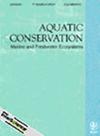High Vulnerability of Rhodolith Bed Frameworks and Underlying Sediment to Ongoing Ocean Climate Change
Abstract
Rhodoliths are non-geniculate, free-living coralline red algae that can accumulate on the seafloor and form structurally complex habitats supporting highly biodiverse communities termed rhodolith beds. Limited understanding of key rhodolith kinetical attributes and how they scale with environmental variability limits ability to predict changes in rhodolith bed distribution and abundance in a globally changing ocean climate. We carried out two experiments in an oscillatory wave tank to test the effects of (1) rhodolith (Boreolithothamnion glaciale) density and wave velocity on rhodolith displacement and abrasion over a hard substratum and (2) rhodolith density on rhodolith displacement and the stability of underlying sediment. We established that on a hard substratum, (1) a threshold wave velocity of ~0.3 m s−1 is required to induce noticeable displacement in average-sized rhodoliths and (2) rhodolith abrasion increases (quasi-linearly) with wave velocity up to this threshold. We also showed that (3) for a same rhodolith density, rhodolith displacement is at least two times smaller on a sedimentary than hard substratum and (4) the loss of sediment underneath rhodoliths decreases (quasi-linearly) with an increase in rhodolith density. Rates documented and strong scaling with changes in water motion and rhodolith density indicate that relatively small changes in the density of rhodoliths or hydrodynamic forces can quickly destabilize rhodolith bed frameworks and underlying sediment. These rates can be used to develop predictive models of change in rhodolith bed distribution and abundance that can in turn inform development of more accurate, science-based rhodolith bed conservation strategies.

 求助内容:
求助内容: 应助结果提醒方式:
应助结果提醒方式:


